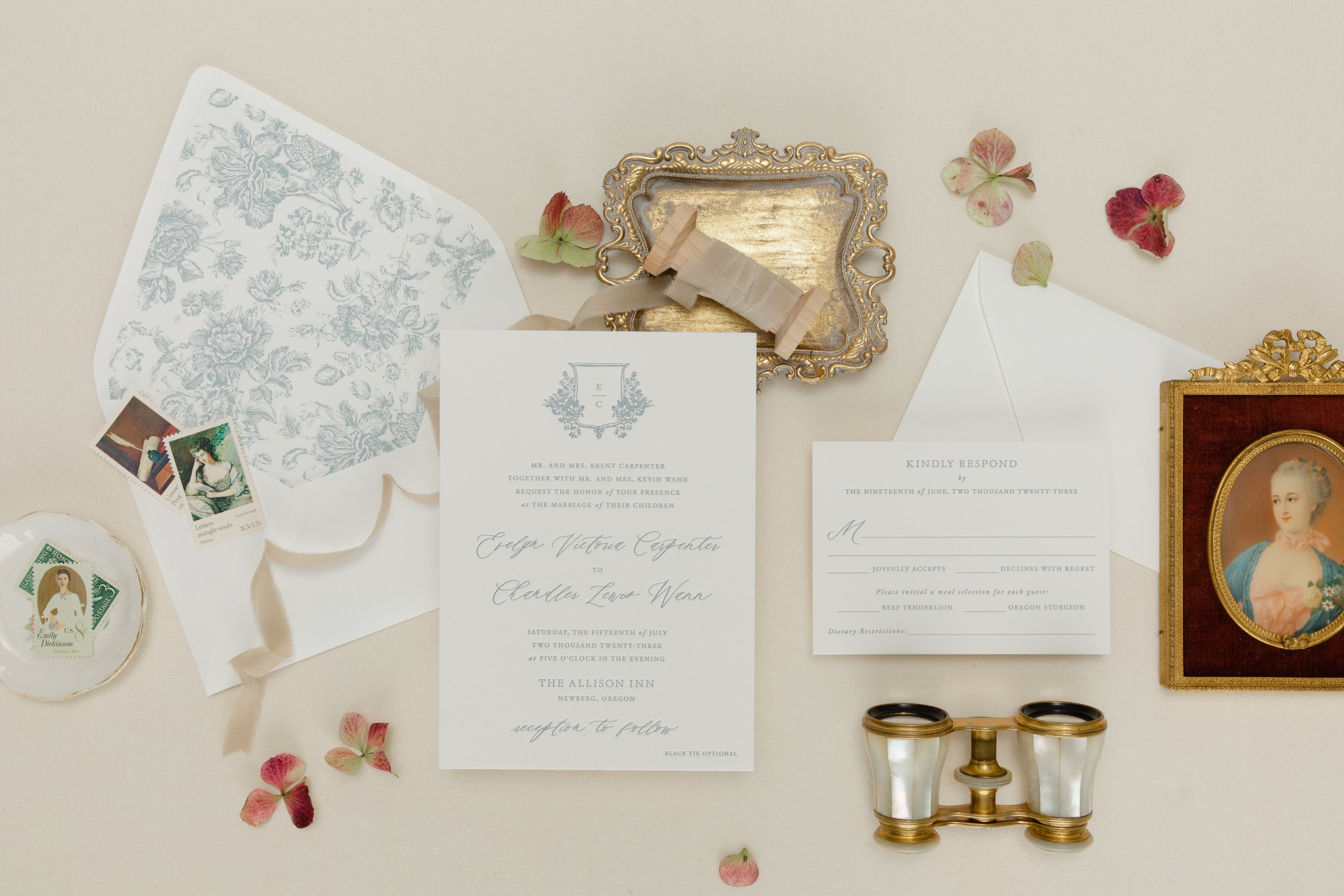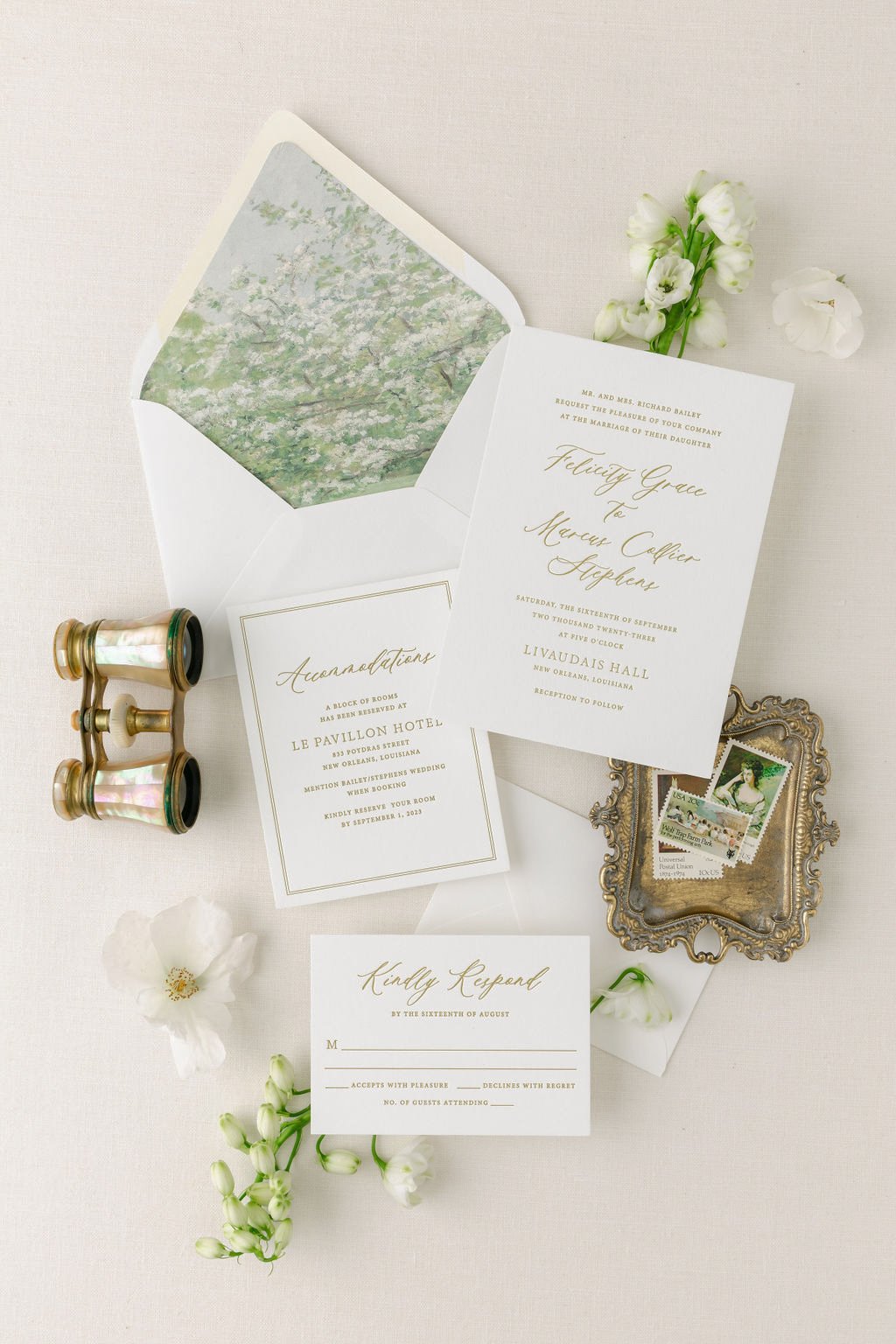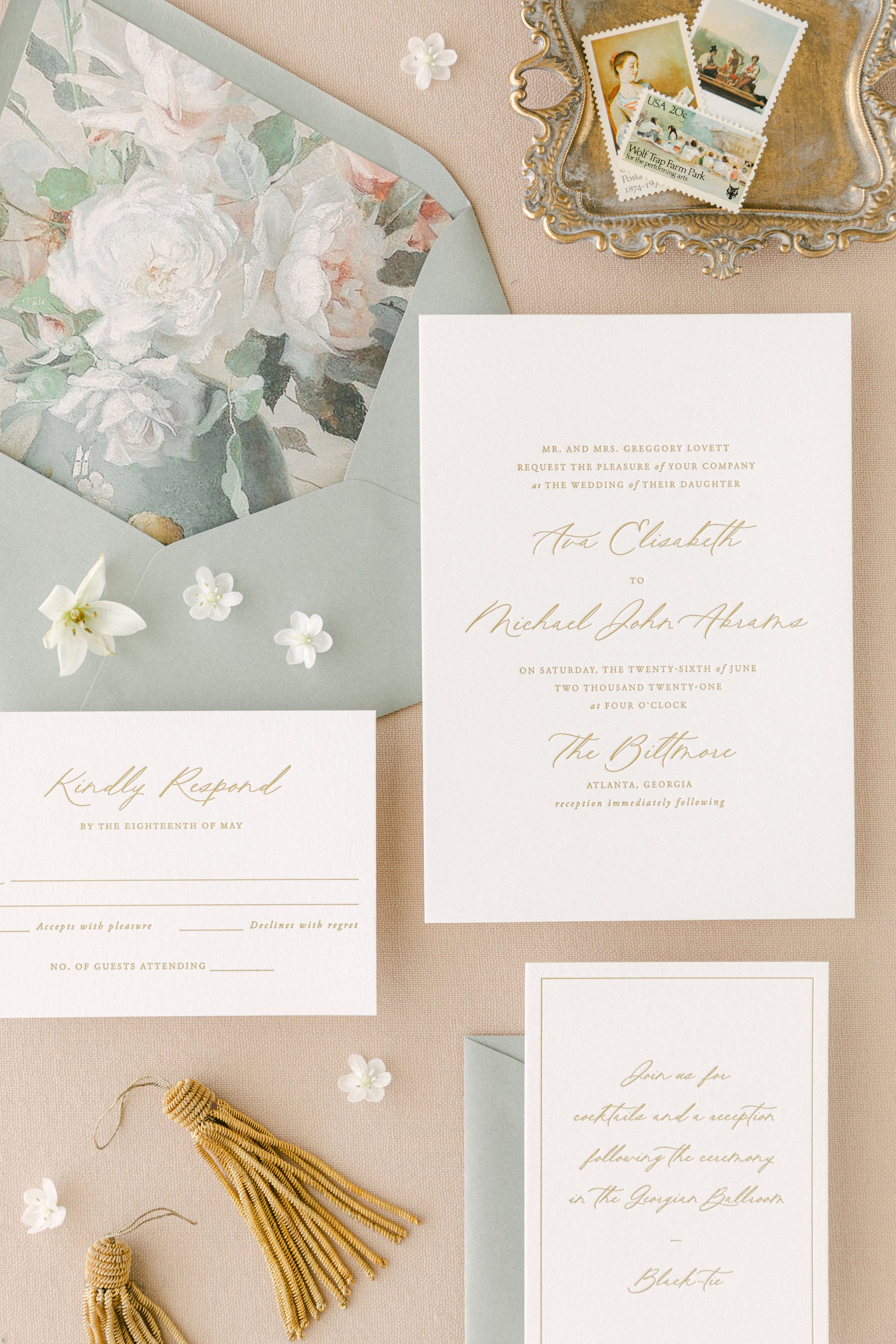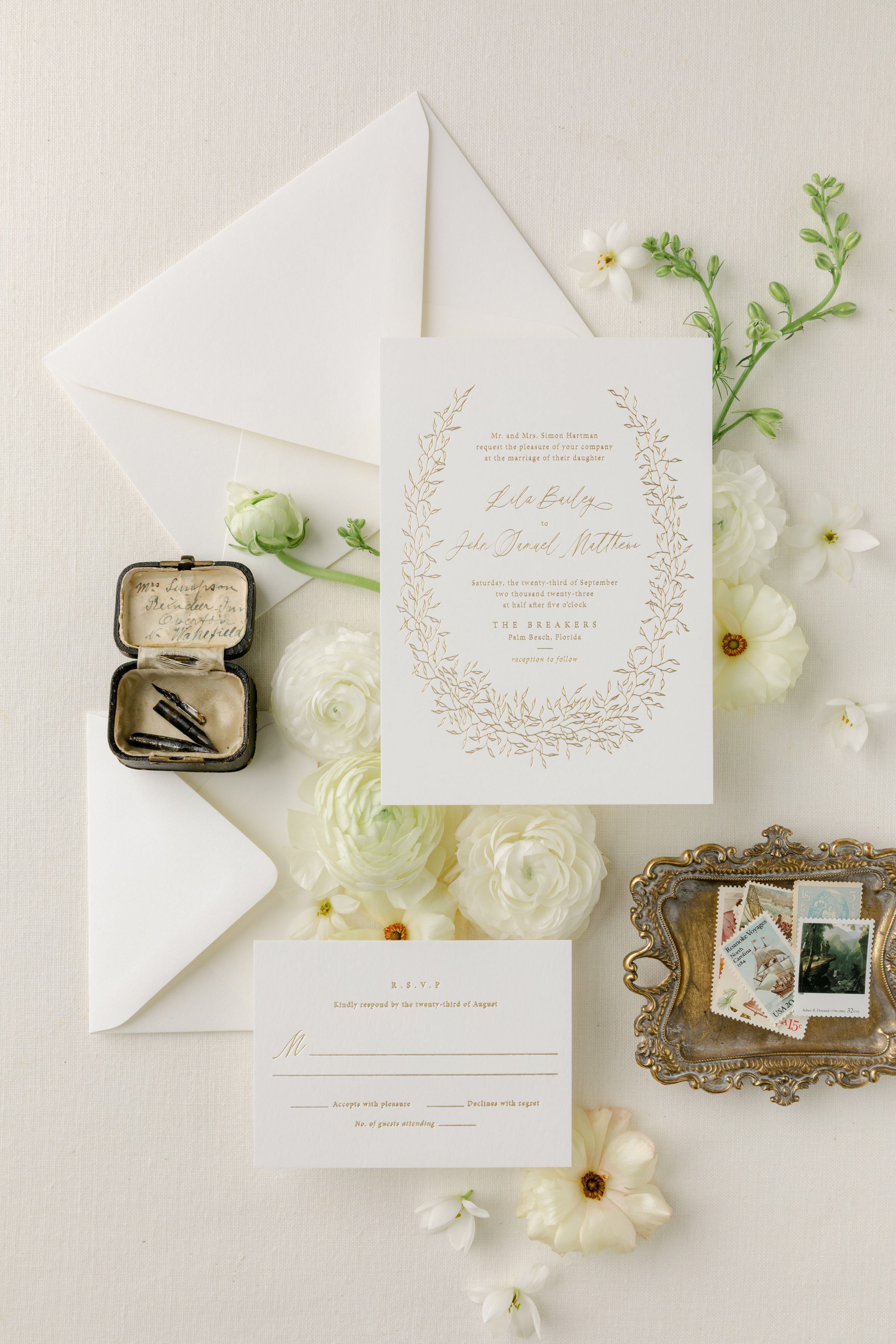Your Complete Wedding Stationery Checklist
Feeling a bit daunted by wedding paper goods? Don't be! This wedding stationery checklist will outline everything you need (and don't need) for your wedding. From the necessary invitations to the sentimental extras, here's a complete wedding stationery list.
Engagement Party Invitations
Throwing a celebratory soiree is the perfect way to announce or commemorate a recent engagement. Engagement parties are optional, but for those who opt in, sending an invitation is a must. Your engagement party invitations don't have to be an exact match to your wedding invitations (after all, you're probably in the early stages of planning), but it's a good rule of thumb for the stationery to be reflective of your general wedding concept.
Card Size: Typically A7 (5" x 7") with a coordinating A7 envelope.
Bridesmaid Proposal Cards
This fun trend is certainly catching on! In addition to asking your BFFs to be your bridesmaid in person, some brides choose to make the event even more memorable with bridesmaid proposal cards. These are usually folded cards with a blank inside so you can hand write your own personalized message.
Card Size: Usually folded A2 cards (4.25" x 5.5" when folded) with a coordinating envelope.
Save the Date Cards
Once you've set a date, it's time to send out save the date cards. Customarily, very little information is provided here. All you'll really need to list are the bride and groom's names, the date and the city where the wedding will take place. Additional information such as the venue and the time of the wedding are omitted, even for destination weddings. You may also include a wedding website to direct guests to more information. At the bottom of the card, it is common to put "formal invitation to follow". Save the Date cards do not have to coordinate with your wedding, but my personal preference is for them to match. Matching save the dates and invitations will help to create a look of cohesiveness.
Although save the date cards are gaining popularity, they are not a requirement. For those having a wedding near a holiday or with several out of town guests, it is a nice gesture to send save the date cards.
Card Size: Usually A7 (5" x 7") or A2 (4.25" x 5.5") with a coordinating A7 or A2 envelope. They can also be sent out as postcards (no bigger than 4.25" x 5.5").
Bridal Shower Invitations
Typically, the bridal shower host will select these. However, you may keep some of your favorite bridal shower designs in mind to suggest to the host if they ask for help. These do not have to coordinate with your wedding (although they should coordinate with your shower) and are typically less formal, so mix it up and have fun!
Card Size: Typically A7 (5" x 7") with a coordinating A7 envelope.
Bridal Shower Thank You Cards
After your bridal shower, it is customary to send a Thank You note to each guest for their generous gift. Be sure to collect addresses ahead of time from the bridal shower host. You may also want to designate someone to write down who each gift came from so you can properly express gratitude in your card.
Card Size: Usually folded cards, sizes range from A7 (5" x 7" when folded) or A2 (4.25" x 5.5" when folded) with a coordinating envelope. They can also be sent out as postcards (no bigger than 4.25" x 5.5").
Wedding Invitations
Whether they're fun or formal, wedding invitations are the single most important aspect of your wedding stationery. Invitations include the host of the wedding (bride's parents, both families, etc.), the bride and groom's names, wedding date and time, venue name, and the city and state. Any other information should be listed on separate cards.
Card Size: Traditionally A7 (5" x 7") with a coordinating A7 envelope. Formal invitations may also wish to include an outer A7.5 envelope to enclose the entire suite.
Response Card (or RSVP)
Always include a separate response card with your invitation, even if you are requesting guests reply online. Including website information or RSVP information on the main invitation can clutter the design. The information included on a response card should be the reply by date, a line for their name, a response (accepts/regrets) and a space for recipients to write in the number of guests attending. You may also want to include a meal option when needed and/or a line to list dietary restrictions. To save on costs, opt for a postcard RSVP. Formal response cards are sent self-addressed and pre-stamped as a courtesy for guests.
Card Size: Customarily 4Bar (3.5" x 5") or A2 (4.25" x 5.5") with a coordinating 4Bar or A2 envelope. They can also be sent out as postcards (no bigger than 4.25" x 5.5").
Enclosure Card (or Insert Card)
This card is reserved for additional information guests may need to know, such as room blocks, reception information or a wedding website. Keep in mind that sending a full page of information to guests can be exasperating and recipients may not read it all the way through. Keep your enclosure cards brief by only including the basics. An easy way to break down a lot of information for guests is by including separate enclosure cards for each detail, such as accommodations, reception, etc.
Card Size: Typically A2 (4.25" x 5.5"), but also larger up to A6 (4.5" x 6.25"). In any event, enclosure cards should never be larger than your wedding invitation.
Accommodation CardYou may list room blocks on a separate accommodations card if you have a few options for guests to choose from or if you need more room than what is on the enclosure card.
Card Size: Usually A2 (4.25" x 5.5"), but also larger up to A6 (4.5" x 6.25").
Reception CardVery formal wedding invitations will include reception information on a separate card. If your wedding and reception are at the same venue, this is typically not needed. However, if you are hosting a reception later in the day or at a different venue than the ceremony, it is a nice gesture to include a reception information on a separate card in order to outline all of the details.
Card Size: Commonly 4Bar (3.5" x 5") or A2 (4.25" x 5.5").
RegistryTraditionally, it is considered rude to list registry information. However, if you would like to indicate your registry information in a nice way to guests, you may include it on a separate registry card. A registry card is usually small, around business card size, and can easily be tucked into your invitation suite.
Card Size: No bigger than business card size (2" x 3.5").
Website CardWhile a web address can easily be added to any enclosure card, some guests prefer to list it on a separate card. It's also an easy way to point guests to one spot that sums up all of the information they may want to look at. If you need to cut invitation costs or if you have a lot of extra details, you can omit the enclosure card options and simply point guests to the website. The downfall may be that older guests who aren't tech savvy may not be as obliged to look online.
Card Size: No bigger than business card size (2" x 3.5").
Rehearsal Dinner Invitations
Though not a requirement, rehearsal dinner invitations make a lovely addition to your wedding paper suite. It is also the most effective way to spread the word about your rehearsal and gives guests a heads up on what to expect.
Card Size: Typically A7 (5" x 7") with a coordinating A7 envelope. They can also be sent as a smaller enclosure card along with your wedding invitations.
Bachelor/Bachelorette Party Invitations
It's likely that you won't be planning this one, but it is customary for the host to send out invitations. Since traditionally only bridal party members are invited to the event, most hosts skip the invitation and spread the news by word of mouth. However, I recommend sending invitations (either electronically or regular mail) to omit any unnecessary confusion. An invitation will be especially helpful for larger bridal parties and for any participant who lives out of town.
Card Size: Typically A7 (5" x 7") with a coordinating A7 envelope.
Ceremony Programs
A lovely way to include guests in the wedding festivities, ceremony programs not only outline what guests can expect (i.e. the order of the ceremony) but they also recognize bridal party members and other notable people in your wedding. Programs are not required, but they make beautiful keepsakes of your big day. Customarily, these will coordinate with your invitation suite.
Card Size: Varies but typically #10 (3.875" x 9.25") or A7 (5" x 7"). Weddings with a lot of information can also be folded or booklet style A7 (5" x 7" when folded).
Guest Book
A beautiful keepsake to commemorate the big day, guest books are a fun yet sentimental part of your wedding. It's a formal way for guests to write sweet notes or simply sign their name in support of your nuptials. Guest books are optional.
Book Size: Varies, but typically an 8" x 10" bound book.
Escort Cards/Escort Board
If you have seating assignments, an escort board or escort cards are a must. These will list each table number, along with names of guests sitting at that table. An escort board is usually one large sign with all table numbers and names of guests. An escort board can have names grouped by table number (all names under each table) or alphabetically by last name. Escort cards are usually similar to place cards and are displayed on a table for all guests to see.
Card Size: Escort boards vary in size, ranging from 11" x 14" and up. Escort cards are usually no bigger than business card size (folding down to 2" x 3.5").
Place Cards
Not to be confused with escort cards, place cards simply list the guest's name and indicate their seat (or "place") at the table. Place cards are (as the name implies) placed on the table setting of each person. Generally, place cards only include the person's first name, but if you have guests with the same first name you may add a last initial to omit any confusion.
Card Size: Place cards are traditionally folded and fold down to business card size (2" x 3.5").
Table Numbers
For those who opt in to assigned seating, table numbers are a must to indicate where guests should go. You can get creative with these, but it is recommend for them to coordinate with your overall wedding concept.
Card Size: Varies, but usually A7 (5" x 7").
Menus
Menus are a great way to really pull your tablescape together, and they're very purposeful in letting guests know what to expect. Whether you're hosting a sit down dinner or a buffet style affair, this is a great way to indicate to guests what's on the menu. After all, sometimes the meal what guests look forward to most.
Card Size: Varies, but usually A7 (5" x 7").
Wedding Table Thank You Notes to Guests
I adore this sentimental wedding trend! Instead of a menu (or in addition to), many couples are placing a sweet thank you note to wedding guests at each place setting. These are typically printed with the same message on each card and include the couples' new married name. Add a personal touch by hiring a calligrapher to write each guests' name at the top, which would make this note also double as a place card.
Card Size: Varies, but usually A7 (5" x 7") or tea length (3.875" x 9.25").
Wedding Welcome Bag Notes
It is considered a nice gesture to include a welcome gift bag for those who have traveled a long way to celebrate with you. You can leave them at the front desk of the hotel or offer them at your wedding rehearsal dinner. It is common to include a thank you note for guests traveling to celebrate with you, a timeline of wedding weekend events, things to do in the area and any other necessary details.
Card Size: Welcome notes are A7 (5" x 7) or smaller.
Wedding Welcome Bag Tags or Labels
As the name implies, these tags or labels adorn your welcome bag. You may choose a small hang tag or apply an adhesive label to each gift. The tag or label should be brief, only including a short welcome and listing the bride and groom's names and wedding date.
Card Size: Varies, gift tags are generally 2" x 3.5" or 2.75" square. Labels for gable boxes may be larger, around 5" x 4". Measure your welcome gift to make sure you have an appropriate size for each bag.
Wedding Signs
Wedding signs are a fun and informative element to add to your ceremony and reception decor. Ranging from small to large, these come in all shapes, sizes and styles.
Card Size: Varies, small signs are typically 5" x 7" and large signs can be upwards of 24" x 36".
Thank You Cards
The final piece of the wedding paper puzzle, thank you cards are most certainly a bridal "do". Have your new husband help out. You may choose to thank all guests who attended (whether they bring a gift or not), but it is definitely required to thank guests who brought a gift. Designate a person to help you remember who gave what so you can properly thank them in your note.
Card Size: Typically folded cards, sizes range from A7 (5" x 7" when folded) or A2 (4.25" x 5.5" when folded) with a coordinating envelope. They can also be sent out as postcards (no bigger than 4.25" x 5.5").
A Few Stationery Recommendations
Wedding stationery serves one of the most important purposes: to outline what guests can expect at your affair, from the invitation right down to the table numbers. It's a polite way of providing guidance along the way for guests. While all stationery is not necessary, keep in mind that it is a great way to make guests feel informed and included.
My recommendation is to hire a stationer who can design all of your wedding stationery–from your invitations to the place cards. This can truly make your wedding one beautiful cohesive affair.
We hope this post has been helpful for you! Keep this suggested timeline in your back pocket (or Pin to your Pinterest board), so you’ll stay on track.
related blog posts











